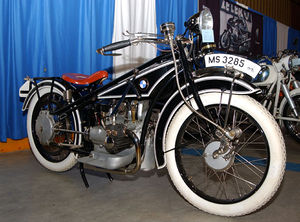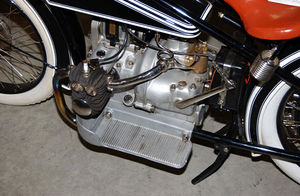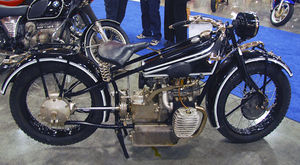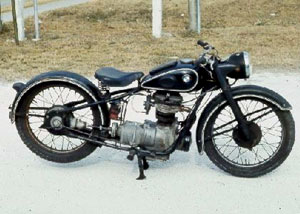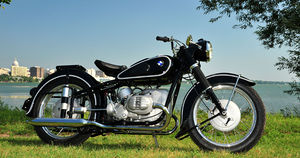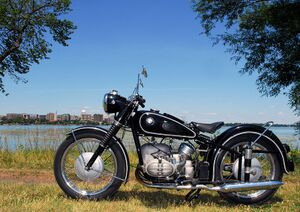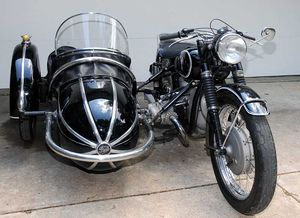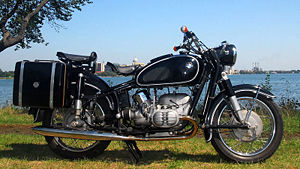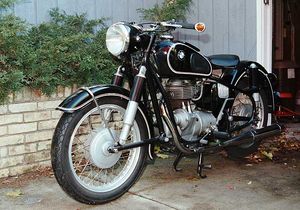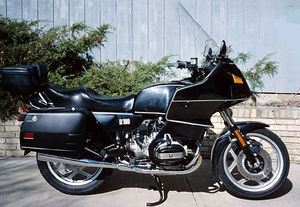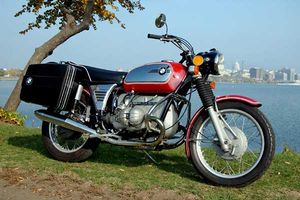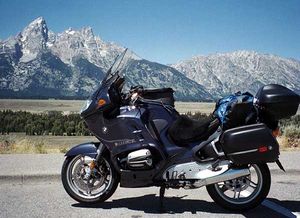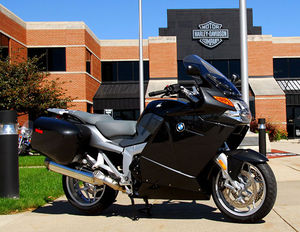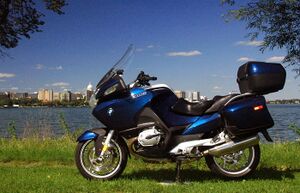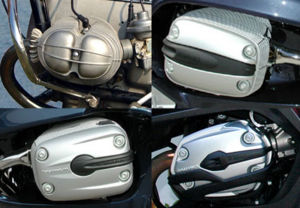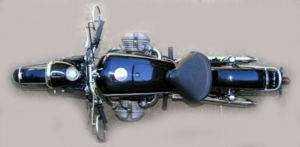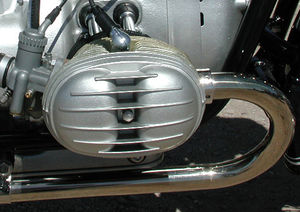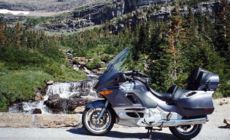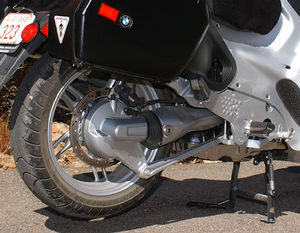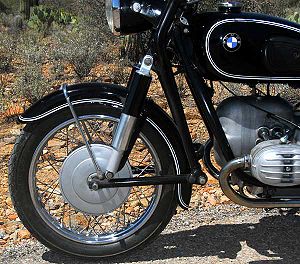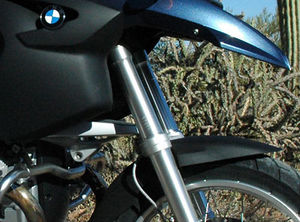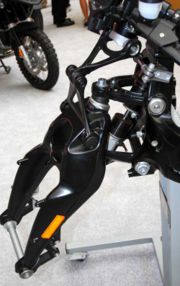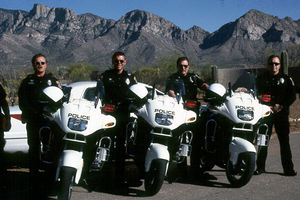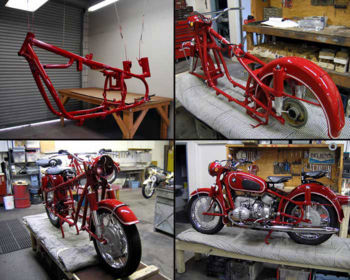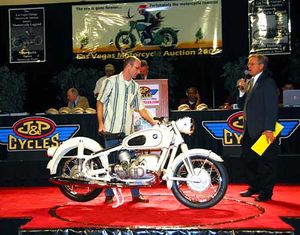BMW motorcycles: Difference between revisions
imported>Jeffrey M. Dean |
mNo edit summary |
||
| (20 intermediate revisions by 8 users not shown) | |||
| Line 1: | Line 1: | ||
{{subpages}} | |||
[[Image:R32-pn.jpg|thumb|365px|A 1924 BMW R32 at the 2006 BMW MOA international rally in Vermont]] | [[Image:R32-pn.jpg|thumb|365px|A 1924 BMW R32 at the 2006 BMW MOA international rally in Vermont]] | ||
'''BMW''' began as an airplane engine manufacturer. But after [[World War I]], the [[Treaty of Versailles]] banned any German air force, so the company turned to [[motorcycle]] engine design and manufacturing. In 1923, BMW introduced the first motorcycle under its name, the '''R32'''. Since then, it has moved to become a successful manufacturer of refined motorcycles. | '''BMW''' began as an airplane engine manufacturer. But after [[World War I]], the [[Treaty of Versailles]] banned any German air force, so the company turned to [[motorcycle]] engine design and manufacturing. In 1923, BMW introduced the first motorcycle under its name, the '''R32'''. Since then, it has moved to become a successful manufacturer of refined motorcycles. | ||
This article covers shaft-driven BMW motorcycles from 1923 to the present. BMW's recently developed chain-driven and belt-driven motorcycles will be covered in one or more separate articles. | This article covers shaft-driven BMW motorcycles from 1923 to the present. BMW's recently developed chain-driven and belt-driven motorcycles will be covered in one or more separate articles. | ||
==BMW | ==BMW motorcycle history== | ||
===1916 to 1945=== | ===1916 to 1945=== | ||
In 1916, two companies, Gustav Otto's '''Flugmaschinenfabrik''' (Airplane Factory) and Karl Rapp's '''Flugwerke Deutschland''', merged to form the '''Bayerische Flugzeugwerke''' (Bavarian Airplane Works). Initially this company designed and manufactured airplane engines. The Bayerische Flugzeugwerke was renamed the '''Bayerische Motoren Werke''' (BMW) in 1917 by Karl Rapp and Max Friz. Its new logo grew out of the older Rapp logo but used Bavaria's blue and white colors. After 1929 the logo was associated with a spinning propeller as a marketing tool.<ref>[http:// | In 1916, two companies, Gustav Otto's '''Flugmaschinenfabrik''' (Airplane Factory) and Karl Rapp's '''Flugwerke Deutschland''', merged to form the '''Bayerische Flugzeugwerke''' (Bavarian Airplane Works). Initially this company designed and manufactured airplane engines. The Bayerische Flugzeugwerke was renamed the '''Bayerische Motoren Werke''' (BMW) in 1917 by Karl Rapp and Max Friz. Its new logo grew out of the older Rapp logo but used Bavaria's blue and white colors. After 1929 the logo was associated with a spinning propeller as a marketing tool.<ref>[http://bmwdean.com/roundel-myth.pdf The Origin of the BMW Logo]</ref> The roundel is still used today on all BMW motorcycles and automobiles. A former Daimler employee, Joseph Popp became BMW's managing director. | ||
[[Image:Vech-r32.jpg|thumb|left|Craig Vechorik's R32]] | [[Image:Vech-r32.jpg|thumb|left|Craig Vechorik's R32]] | ||
| Line 21: | Line 15: | ||
The first "boxer" engine, '''M2B15''', was based on a British Douglas design. It was manufactured by BMW but mostly used in other brands of motorcycles, notably Victoria of Nuremberg. The M2B15 proved to be moderately successful and BMW used it in its own Helios motorcycle. BMW also developed and manufactured a small 2-stroke motorcycle called the Flink, which was not successful. However with the development of its first light alloy cylinder head, a second more successful version of the boxer engine evolved. | The first "boxer" engine, '''M2B15''', was based on a British Douglas design. It was manufactured by BMW but mostly used in other brands of motorcycles, notably Victoria of Nuremberg. The M2B15 proved to be moderately successful and BMW used it in its own Helios motorcycle. BMW also developed and manufactured a small 2-stroke motorcycle called the Flink, which was not successful. However with the development of its first light alloy cylinder head, a second more successful version of the boxer engine evolved. | ||
[[Image:Bmw-r62.jpg|thumb|left|1928 side-valve BMW R62]] | [[Image:Bmw-r62.jpg|thumb|left|1928 side-valve BMW R62]] | ||
In 1923, the first BMW branded motorcycle, the '''R32''' <ref>[http:// | In 1923, the first BMW branded motorcycle, the '''R32''' <ref>[http://bmwdean.com/r32.htm BMW R32] web page</ref>, was produced. Using the new aluminium alloy cylinders, Friz designed a 486 cc engine with 8.5 hp (6.3 kW) and a top speed of 95-100 km/h (60 mph). <ref>[http://bmwdean.com/r32.html R32 Specs] BMW R32 specifications</ref> The engine and gear box formed a single unit construction. The new engine featured a recirculating wet-sump oiling system that was advanced for 1923. Most motorcycle manufacturers used a total-loss oiling system in 1923. BMW used this type of recirculating oiling system until 1969. | ||
The R32 became the foundation for all future boxer powered BMW motorcycles. BMW oriented the boxer engine with the cylinder heads projecting out on each side for cooling. The R32 also incorporated a shaft drive. BMW continued to use shaft drives in all of its opposed-twin motorcycles until the present. In 1935, BMW introduced the world's first production motorcycle to use oil-damped telescopic forks. | The R32 became the foundation for all future boxer powered BMW motorcycles. BMW oriented the boxer engine with the cylinder heads projecting out on each side for cooling. The R32 also incorporated a shaft drive. BMW continued to use shaft drives in all of its opposed-twin motorcycles until the present. In 1935, BMW introduced the world's first production motorcycle to use oil-damped telescopic forks. | ||
| Line 29: | Line 23: | ||
===1945 to 1960=== | ===1945 to 1960=== | ||
[[Image:R24.jpg|thumb|The first postwar BMW, an original condition 1948 250cc BMW R24]] | [[Image:R24.jpg|thumb|The first postwar BMW, an original condition 1948 250cc BMW R24]] | ||
[[Image:R68-700.jpg|thumb | [[Image:R51-600.jpg|thumb|left|1954 500cc BMW R51/3]] | ||
[[Image: | [[Image:R68-700.jpg|thumb|1954 R68: BMW's first 100 MPH motorcycle]] | ||
The end of World War II found BMW in ruins. Its plant outside of Munich was destroyed by allied bombing. It is commonly alleged that an entire assembly line in the | [[Image:R68-sidecar.jpg|thumb|left|BMW R68 with Steib sidecar]] | ||
The end of World War II found BMW in ruins. Its plant outside of Munich was destroyed by allied bombing. It is commonly alleged that an entire assembly line in the Eisenach facility was dismantled by the Soviets as reparations and sent it back to the Soviet Union where it was reassembled in Irbit to make Ural motorcycles. However the IMZ plant was supplied to the Soviets by BMW under license prior to the commencement of the Great Patriotic War. After the war the terms of Germany's surrender forbade BMW from manufacturing motorcycles. Most of BMW's brightest engineers were taken to the US and Russia to continue their work on jet engines which BMW produced during the war. | |||
When the ban on the production of motorcycles was lifted in Allied controlled Western Germany, BMW had to start from scratch. There were no plans, blueprints, or schematic drawings. Company engineers had to use surviving prewar motorcycles to create new plans. The first post-war BMW motorcycle in Western Germany, a 250cc R24, was produced in 1948. The R24 was based on the prewar R23, and was the only postwar BMW with no rear suspension. In 1949, BMW produced 9,200 units and by 1950 production surpassed 17,000 units. | When the ban on the production of motorcycles was lifted in Allied controlled Western Germany, BMW had to start from scratch. There were no plans, blueprints, or schematic drawings. Company engineers had to use surviving prewar motorcycles to create new plans. The first post-war BMW motorcycle in Western Germany, a 250cc R24, was produced in 1948. The R24 was based on the prewar R23, and was the only postwar BMW with no rear suspension. In 1949, BMW produced 9,200 units and by 1950 production surpassed 17,000 units. | ||
The situation was somewhat different in Soviet-controlled Eastern Germany where the Eisenach plant was producing R35 and a handful of R75 motorcycles for reparations. Eventually this plant became | The situation was somewhat different in Soviet-controlled Eastern Germany where the Eisenach plant was producing R35 and a handful of R75 motorcycles for reparations. Eventually this plant became EMW (Eisenacher Motoren Werke). | ||
In 1952, BMW introduced its first postwar sporting motorcycle, the R68. Only 1,453 R68s were made, making it the rarest postwar BMW motorcycle. It has a 594 cc single cam engine with 8.0:1 compression ratio and larger valves, together producing 35 HP. The carburetor venturi throat sizes were 26 mm. | In 1952, BMW introduced its first postwar sporting motorcycle, the R68. Only 1,453 R68s were made, making it the rarest postwar BMW motorcycle. It has a 594 cc single cam engine with 8.0:1 compression ratio and larger valves, together producing 35 HP. The carburetor venturi throat sizes were 26 mm. | ||
On June 8, 1959, John Penton rode a BMW R69 from New York to Los Angeles in 53 hours and 11 minutes, setting a new record. | On June 8, 1959, John Penton rode a BMW R69 from New York to Los Angeles in 53 hours and 11 minutes, setting a new record. | ||
<br><br> | |||
===1960 to 1982=== | ===1960 to 1982=== | ||
| Line 80: | Line 77: | ||
====R Series==== | ====R Series==== | ||
[[Image:Gss-600.jpg|thumb|left|Two BMW Gelände/Strasse|R1200GSs at Montezuma Pass, Arizona]] | [[Image:Gss-600.jpg|thumb|left|Two BMW Gelände/Strasse|R1200GSs at Montezuma Pass, Arizona]] | ||
{{Image|R1200c.jpg|left|230px|R1200C Cruiser}} | |||
[[Image:R1200rt-blue.jpg|thumb|right|300px|2007 BMW R1200RT|R1200RT available in Biarritz blue]] | [[Image:R1200rt-blue.jpg|thumb|right|300px|2007 BMW R1200RT|R1200RT available in Biarritz blue]] | ||
In 2004, bikes with the opposed-twin cylinder "boxer" engine were also revamped. The new boxer displacement is just under 1200cc, and is affectionately referred to a "hexhead" because of the shape of the | In 2004, bikes with the opposed-twin cylinder "boxer" engine were also revamped. The new boxer displacement is just under 1200cc, and is affectionately referred to a "hexhead" because of the shape of the engine's valve covers. The motor itself is more powerful, and all of the motorcycles that use it are lighter. | ||
The first motorcycle to be launched with this updated engine was the R1200GS dual-purpose motorcycle. The R1200RT tourer and R1200ST sports tourer followed. BMW then introduced two special editions: the new R1200GS, designated the HP2, and the R1200GS Adventure, targeting the off-road and adventure-touring motorcycle segments, respectively. | The first motorcycle to be launched with this updated engine was the R1200GS dual-purpose motorcycle. The R1200RT tourer and R1200ST sports tourer followed. BMW then introduced two special editions: the new R1200GS, designated the HP2, and the R1200GS Adventure, targeting the off-road and adventure-touring motorcycle segments, respectively. | ||
| Line 91: | Line 88: | ||
==Technologies== | ==Technologies== | ||
====R series==== | ====R series==== | ||
{{Image|4-heads.jpg|right|300px|Four different BMW valve covers}} | |||
{{Image|Opposed-cylinders-r68.jpg|left|300px|A 1954 R68 shows BMW's opposed cylinders.}} | |||
The R series engines are built around a two piston, horizontally opposed flat-twin (so-called "boxer") engine. As the engine is mounted with a longitudinal crankshaft, the cylinder heads protrude well beyond the sides of the frame, making the R series motorcycles are quite distinctive visually and providing excellent cylinder cooling in the airstream. Such engines run approximately 100° cooler than the more common V-twin motorcycle engine design. | The R series engines are built around a two piston, horizontally opposed flat-twin (so-called "boxer") engine. As the engine is mounted with a longitudinal crankshaft, the cylinder heads protrude well beyond the sides of the frame, making the R series motorcycles are quite distinctive visually and providing excellent cylinder cooling in the airstream. Such engines run approximately 100° cooler than the more common V-twin motorcycle engine design. | ||
| Line 102: | Line 99: | ||
====K series==== | ====K series==== | ||
{{Image|Ltglac-600.jpg|right|230px|A K1200LT at Glacier National Park}} | |||
The K series are built around liquid cooled, inline engines with three | The K series are built around liquid cooled, inline engines with three | ||
(K75) or four (K100, K1100, K1200) cylinders. Originally the engine was longitudinal: the crankshaft is in line with the | (K75) or four (K100, K1100, K1200) cylinders. Originally the engine was longitudinal: the crankshaft is in line with the | ||
direction of motion. Also, the cylinders are banked over, parallel to the ground. The | direction of motion. Also, the cylinders are banked over, parallel to the ground. The longitudinally-mounted inline BMW motorcycle engine was sometimes called the "Flying Brick". The first K production bike was the K100, which was introduced in 1983 and was followed by the K100RS and K100RT versions. These were followed by the K1100RS, K1100RT, and K1100LT models. In 1998 BMW increased the size again to 1170 cc. This upgraded flat four engine appeared in the K1200RS. In 2003, a new variation of the K1200RS appeared and was designated the K1200GT. The K1200GT was equipped with hard side cases, larger windshield with electric height adjustment, and a larger fairing. The chassis of the K1200RS was extended and strengthened for BMW's luxury touring model the K1200LT. In 2006 BMW introduced a new K1200 engine is smaller and is oriented with the crankshaft at 90 degrees to the frame. The new K1200 engine has a significant increase in power — 112 kW (152 hp). The new four cylinder, liquid cooled engine first appeared in the 2005 K1200S and was followed by the K1200R, 2007 K1200GT and 2007 K1200R. | ||
====Paralever==== | ====Paralever==== | ||
| Line 160: | Line 157: | ||
Two American membership organizations, Vintage BMW Motorcycle Owners [http://www.vintagebmw.org/current/] and the Veteran BMW Motorcycle Club of America [http://bmwvmca.org/] are dedicated to the preservation of vintage BMW motorcycles.<br style="clear:both;"> | Two American membership organizations, Vintage BMW Motorcycle Owners [http://www.vintagebmw.org/current/] and the Veteran BMW Motorcycle Club of America [http://bmwvmca.org/] are dedicated to the preservation of vintage BMW motorcycles.<br style="clear:both;"> | ||
== | == Eastern descendants == | ||
The Soviets manufactured some BMW designs under license before the [[Second World War]]. After the war, they took equipment from BMW factories as part of their reparations. As a result, a number of companies in Communist countries have been making motorcycles to what are basically BMW designs for decades. | |||
The companies include [http://www.russiancycles.com/ Dnepr] in the Ukraine, [http://www.ural.com/ Ural] in Russia, [http://www.chang-jiang.com/motocycle.html Chang Jiang] in China, and others. Nearly all these machines are 750 cc bikes and have sidecars. Many use side-valve engines resembling the R71; others have overhead valves. Many are used by the police or military of the manufacturing countries, but some are privately owned and some are exported. They are fairly popular with travellers in China and [http://wikitravel.org/en/Driving_in_China#Motorcycles Wikitravel] has a discussion of them from that point of view. | |||
Some of the Soviet military bikes, built by Dnepr, had two-wheel drive (a shaft delivered power to the sidecar wheel) and very high ground clearance to cope with difficult off-road conditions. | |||
==References== | |||
[[Category: | {{reflist}}[[Category:Suggestion Bot Tag]] | ||
Latest revision as of 11:00, 15 July 2024
BMW began as an airplane engine manufacturer. But after World War I, the Treaty of Versailles banned any German air force, so the company turned to motorcycle engine design and manufacturing. In 1923, BMW introduced the first motorcycle under its name, the R32. Since then, it has moved to become a successful manufacturer of refined motorcycles.
This article covers shaft-driven BMW motorcycles from 1923 to the present. BMW's recently developed chain-driven and belt-driven motorcycles will be covered in one or more separate articles.
BMW motorcycle history
1916 to 1945
In 1916, two companies, Gustav Otto's Flugmaschinenfabrik (Airplane Factory) and Karl Rapp's Flugwerke Deutschland, merged to form the Bayerische Flugzeugwerke (Bavarian Airplane Works). Initially this company designed and manufactured airplane engines. The Bayerische Flugzeugwerke was renamed the Bayerische Motoren Werke (BMW) in 1917 by Karl Rapp and Max Friz. Its new logo grew out of the older Rapp logo but used Bavaria's blue and white colors. After 1929 the logo was associated with a spinning propeller as a marketing tool.[1] The roundel is still used today on all BMW motorcycles and automobiles. A former Daimler employee, Joseph Popp became BMW's managing director.
At the end of World War I, with the signing of the Treaty of Versailles, Germany was forbidden to manufacture airplanes. Reluctantly Max Friz, BMW's head designer, turned to motorcycle and automobile engines to sustain the company. Friz designed the now-legendary opposed, flat twin cylinder engine known today as the "boxer" engine.
The first "boxer" engine, M2B15, was based on a British Douglas design. It was manufactured by BMW but mostly used in other brands of motorcycles, notably Victoria of Nuremberg. The M2B15 proved to be moderately successful and BMW used it in its own Helios motorcycle. BMW also developed and manufactured a small 2-stroke motorcycle called the Flink, which was not successful. However with the development of its first light alloy cylinder head, a second more successful version of the boxer engine evolved.
In 1923, the first BMW branded motorcycle, the R32 [2], was produced. Using the new aluminium alloy cylinders, Friz designed a 486 cc engine with 8.5 hp (6.3 kW) and a top speed of 95-100 km/h (60 mph). [3] The engine and gear box formed a single unit construction. The new engine featured a recirculating wet-sump oiling system that was advanced for 1923. Most motorcycle manufacturers used a total-loss oiling system in 1923. BMW used this type of recirculating oiling system until 1969.
The R32 became the foundation for all future boxer powered BMW motorcycles. BMW oriented the boxer engine with the cylinder heads projecting out on each side for cooling. The R32 also incorporated a shaft drive. BMW continued to use shaft drives in all of its opposed-twin motorcycles until the present. In 1935, BMW introduced the world's first production motorcycle to use oil-damped telescopic forks.
During World War II, the U.S. Army asked Harley-Davidson to produce a motorcycle as good as BMW's side-valve R71. So Harley copied the BMW engine and transmission — simply converting metric measurements to inches — and produced the shaft-drive 750cc 1942 Harley-Davidson XA[4].
1945 to 1960
The end of World War II found BMW in ruins. Its plant outside of Munich was destroyed by allied bombing. It is commonly alleged that an entire assembly line in the Eisenach facility was dismantled by the Soviets as reparations and sent it back to the Soviet Union where it was reassembled in Irbit to make Ural motorcycles. However the IMZ plant was supplied to the Soviets by BMW under license prior to the commencement of the Great Patriotic War. After the war the terms of Germany's surrender forbade BMW from manufacturing motorcycles. Most of BMW's brightest engineers were taken to the US and Russia to continue their work on jet engines which BMW produced during the war.
When the ban on the production of motorcycles was lifted in Allied controlled Western Germany, BMW had to start from scratch. There were no plans, blueprints, or schematic drawings. Company engineers had to use surviving prewar motorcycles to create new plans. The first post-war BMW motorcycle in Western Germany, a 250cc R24, was produced in 1948. The R24 was based on the prewar R23, and was the only postwar BMW with no rear suspension. In 1949, BMW produced 9,200 units and by 1950 production surpassed 17,000 units.
The situation was somewhat different in Soviet-controlled Eastern Germany where the Eisenach plant was producing R35 and a handful of R75 motorcycles for reparations. Eventually this plant became EMW (Eisenacher Motoren Werke).
In 1952, BMW introduced its first postwar sporting motorcycle, the R68. Only 1,453 R68s were made, making it the rarest postwar BMW motorcycle. It has a 594 cc single cam engine with 8.0:1 compression ratio and larger valves, together producing 35 HP. The carburetor venturi throat sizes were 26 mm.
On June 8, 1959, John Penton rode a BMW R69 from New York to Los Angeles in 53 hours and 11 minutes, setting a new record.
1960 to 1982
Although U.S. sales of BMW motorcycles were strong, BMW was in financial trouble. Through the combination of selling off its aircraft engine division and obtaining financing with the help of Herbert Quandt, BMW was able to survive. The turnaround was thanks in part to the increasing success of BMW's automotive division.
Since the beginnings of its motorcycle manufacturing, BMW periodically introduced single-cylinder models. In 1967, BMW offered the last of these, the BMW R27 [1].
Most of BMW's offerings were still designed to be used with sidecars. By this time sidecars were no longer a consideration of most riders; people were interested in sportier motorcycles. The R50/2, R60/2, and R69S marked the end of sidecar-capable BMWs.
In 1970 BMW introduced an entirely revamped product line of 500, 600 and 750 cc displacement models, the R50/5, R60/5, and R75/5 [2] respectively. The engines were a complete redesign from the older models, producing more power and including electric starting (although the kick-starting feature was still included). The "/5" models were short-lived, however, being replaced by another new product line in 1974. These models were the R60/6, R75/6 and the R90/6. In 1975 a supersport model, the BMW R90S [3], was introduced. The R90S immediately earned the well deserved title of the best supersport machine available.
In 1977 the product line moved on to the "/7" models. The R80/7 was added to the line. The R90 (898 cc) models, "/6" and R90S models had their displacement increased to 1000 cc; replaced by the R100/7 and the R100S, respectively. These were the first liter size (1,000 cc) machines produced by BMW. 1977 was a banner year with the introduction of the first BMW production motorcycle featuring a full fairing, the R100RS. This sleek model, designed through wind-tunnel testing, produced 70 horsepower (51 kW) and had a top speed of 200 km/h (124 mph).[5] In 1978, the R100RT was introduced into the lineup for the 1979 model year as BMW's first "full-dress" tourer.
In 1979 the R60 was replaced with the 650cc R65. With its frame design and a 1962 variant, the R65LS, to include entry level models to the lineup.
1983 to 2003
In early 1983, BMW introduced a 1000 cc, in-line four-cylinder, water-cooled engine to the European market, the K100. In 1984, those models were introduced to the U.S. market. It was assumed that this new engine would not only be the basis for a new models, but would replace the aging boxer flat twin engine. However, demand for the boxer did not wane with the introduction of this new engine and associated models. And the demand of the new engine models was much less than BMW anticipated. Therefore, BMW continued to produce and improve its boxer models.
In 1985 BMW produced a 750 cc, three-cylinder version of the new four-cylinder water cooled engine. The 750 cc had a balance shaft and was smoother. The R100RT, a boxer powered touring bike with a monolever rear suspension, was reintroduced in 1987. BMW introduced a new rear suspension on the K bikes, a double-joined, single-sided swingarm.
In 1988 BMW introduced Anti-lock braking system (ABS) on its motorcycles - a first in the motorcycle industry. ABS became standard on all BMW K models. In 1989, BMW introduced its version of a full-fairing sport bike, the K1. It was based upon the K100 engine, with four valves per cylinder. Output was near 100 bhp (75 kW).
In 1995 BMW ceased production of airhead 2-valve engines and moved its boxer engined line completely over to the newer 4-valve oilhead, which was introduced in 1993.
During this period, BMW introduced 650cc belt- and chain-driven motorcycles denoted with the series prefix "F", which are covered in a separate article.
2004 to the present
K Series
Each of the last few years (2004, 2005, 2006) appear to be banner years for BMW. On 25 September 2004, BMW globally launched a radically redesigned K Series motorcycle, the K1200S, containing an all new in-line four-cylinder, liquid-cooled engine featuring 123 kilowatts (167 bhp).[6] The K1200S was primarily designed as a super sport motorcycle, albeit larger and heavier than the closest Japanese competitors. A K1200S set a land speed record for production bikes in its class at the Bonneville Salt Flats, exceeding 174 miles per hour (280 km/h).
In addition to the launch of K1200S, in 2006 BMW has also launched the K1200R "naked" roadster, and the K1200GT sports tourer. All three new K-Series motorcycles are based on the new in-line four-cylinder engine, with varying degrees of power.
In 2007 BMW added the K1200R Sport[4], a semi-faired sports touring version of the K1200R.
R Series
In 2004, bikes with the opposed-twin cylinder "boxer" engine were also revamped. The new boxer displacement is just under 1200cc, and is affectionately referred to a "hexhead" because of the shape of the engine's valve covers. The motor itself is more powerful, and all of the motorcycles that use it are lighter.
The first motorcycle to be launched with this updated engine was the R1200GS dual-purpose motorcycle. The R1200RT tourer and R1200ST sports tourer followed. BMW then introduced two special editions: the new R1200GS, designated the HP2, and the R1200GS Adventure, targeting the off-road and adventure-touring motorcycle segments, respectively.
In 2006, BMW launched the R1200S, which is rated at 90 kW (122 hp) at 8,250 rpm – the most powerful boxer engine to date.[7] The next model to get the new engine was the R1200R, an update of the successful R1150R. The R1200R also comes with a new version of ABS and sees the introduction of an optional traction control ("ASC" or automatic stability control) system to limit wheel spin, another BMW first.
Technologies
R series
The R series engines are built around a two piston, horizontally opposed flat-twin (so-called "boxer") engine. As the engine is mounted with a longitudinal crankshaft, the cylinder heads protrude well beyond the sides of the frame, making the R series motorcycles are quite distinctive visually and providing excellent cylinder cooling in the airstream. Such engines run approximately 100° cooler than the more common V-twin motorcycle engine design.
From 1923 until a new design started to be introduced for the 1993 model year, BMW engines were air-cooled ("airhead") OHV engines with two valves per cylinder operated by long pushrods from central camshafts. The new engine, the so-called "oilhead" engine, introduced four valves per cylinder for improved power and breathing and short, high pushrods. The latter design was chosen to keep engine width narrower than had BMW chosen to use conventional overhead camshafts.
How do you tell the different BMW valve covers ("heads") since 1970 apart? In the photo of four valve covers, the "airhead" cover on a 1973½ R75/5 is upper left. The first "oilhead" cover, introduced in model year 1996, is upper right. The 2004-only "oilhead" cover on an R1150RT, with two sparkplugs per cylinder, is lower left. The latest "hexhead" cover, with an optional valve cover protector, on an R1200RT, is lower right.
A common valve cover from 1952 to 1969 on models R68, R50, R60, R50/2, R60/2, R51/3, R67, R67/2, R67/3 had six fins. The R50S, R69, and R69S of this period had valve covers similar to that on the R75/5 in the upper left corner photo to the right.
K series
The K series are built around liquid cooled, inline engines with three (K75) or four (K100, K1100, K1200) cylinders. Originally the engine was longitudinal: the crankshaft is in line with the direction of motion. Also, the cylinders are banked over, parallel to the ground. The longitudinally-mounted inline BMW motorcycle engine was sometimes called the "Flying Brick". The first K production bike was the K100, which was introduced in 1983 and was followed by the K100RS and K100RT versions. These were followed by the K1100RS, K1100RT, and K1100LT models. In 1998 BMW increased the size again to 1170 cc. This upgraded flat four engine appeared in the K1200RS. In 2003, a new variation of the K1200RS appeared and was designated the K1200GT. The K1200GT was equipped with hard side cases, larger windshield with electric height adjustment, and a larger fairing. The chassis of the K1200RS was extended and strengthened for BMW's luxury touring model the K1200LT. In 2006 BMW introduced a new K1200 engine is smaller and is oriented with the crankshaft at 90 degrees to the frame. The new K1200 engine has a significant increase in power — 112 kW (152 hp). The new four cylinder, liquid cooled engine first appeared in the 2005 K1200S and was followed by the K1200R, 2007 K1200GT and 2007 K1200R.
Paralever
Paralever is BMW's rear suspension technology (photo left) that allows the drive shaft to pivot along the same axis as the sprung rear frame due to the addition of second link between the rear drive and transmission. Paralever was originally introduced in 1988 R80GS and R100GS motorcycles. The benefit of the Paralever rear suspension technology is the reduction of the phenomenon known as "shaft jacking," wherein the rear of the motorcycle would lift up under heavy braking and sink downward under heavy acceleration.
Starting with the "hexhead" BMW motorcycles in model year 2005, BMW inverted the Paralever by moving the torque arm from the bottom to the top of the drive shaft housing in order to increase ground clearance in a right turn.
The term Paralever was developed due to the parallelogram shape made by the four items making up the rear suspension. (rear drive, drive shaft, transmission, and lower or upper brace).
Earles front fork
Just as BMW, in the 1930s, was the first manufacturer to put into production oil-dampened telescopic forks, it has continued to be innovative in designing front suspensions for its motorcycles.
From 1955 to 1969, BMW used a unique fork that was designed to accommodate sidecars, even though most of its motorcycles were sold as solo bikes. Designed by Englishman Ernest Earles, this triangulated fork actually caused the front end of a motorcycle to rise when braking hard — the reverse of the action of a telescopic fork.
Telelever front fork
The Telelever system was developed by Saxon-Motodd in Britain in the early 1980s. It is a unique front fork design in which the shock absorber is located between and behind the two primary tubes attached to a telelever arm.
This system both lowers unsprung weight as well as decouples wheel placement function of the forks from the shock absorption function - eliminating brake dive and providing superior traction during hard-braking situations. This system improves comfort and stability considerably while providing excellent and sporty handling.
In the accompanying photo one can see the Telelever suspension unit. The two fork tubes provide no damping or suspension. The front of the light gray "A-arm" can be seen reaching forward from the frame on the left to the cross brace between the fork tubes.
Duolever
In 2003 BMW announced the K1200S with a new front suspension. It incorporated a front suspension that appears to be based upon a design by Norman Hossack. BMW recognised this fact but no royalties were paid to Hossack. A lack of interest and money saw the end of the project in Britain. BMW named its new front suspension the Duolever. As of 2007, the Duolever is on the K1200S, K1200R, K1200R Sport and K1200GT.
The official and extensive BMW Motorrad explanation of the duolever can be read here.
Emergency services
In 2000, BMW was the largest seller of motorcycles for authority use, as more than 70,000 BMW motorcycles were in official use in over 130 countries on five continents. [8] Nearly 100 U.S. law enforcement agencies, including the California Highway Patrol, had BMW police motorcycles in their fleets of patrol vehicles.
The BMW RT-P authority version, the R1100RT-P, R1150RT-P, and R1200RT-P models series are popular with law enforcement agencies. In the U.S. an increasing number of police agencies are using the RT-P, which are usually replacing the Kawasaki Police 1000, because Kawasaki stopped producing police motorcycles in 2005.
In the United Kingdom BMW RT motorcycles are used by both police and paramedics. A number of police forces who previously used the Honda ST1300 Pan European are now evaluating the R1200RT following a number of high profile accidents.[5][6] These accidents, which are reputed to be due to a high speed wobble on the ST1300, have resulted in some police forces retiring their entire ST1300 fleet and in some cases taking older Honda ST1100 models out of mothballs.
Restoration
Admirers of vintage BMW motorcycles are growing rapidly in number. As time marches on, that which BMW enthusiasts consider "vintage" is amended, much as a trailer follows behind a car. Pre-war BMWs are the most coveted, as demonstrated during the Gooding & Company auction in California in October 2006, when a 1925 BMW R32 sold for $77,000.
Plunger-frame models from the 1950s are the next most coveted, and then "Slash-2" variants from 1955-1969. In recent years, the "Slash-5" models from the 1970 to the 1973 model years have begun to join that exclusive club. Prices for historic BMW models have been rising quickly, fed in part by motorcycle auctions such as the massive Mid-America Auction [7] held each January in Las Vegas, Nevada.
Opinions as to the treatment of vintage motorcycle varies according to their condition and their owners' tastes. First preference tends to be for preserving the original machine if it is in reasonably good condition. Second preference is to do limited restoration, maintaining as much of the original fabric as possible.
Third, when dealing with a machine in poor condition, is so-called frame-up restoration. In the latter case, the motorcycle is completely disassembled and each individual part is refurbished, and then the motorcycle is reassembled hewing as much as possible to the original design, but sometimes using modern replacement parts, such as stainless steel, or plating parts that were originally not plated. At the extreme end of restoration is the "concours" restoration in which only original parts are used and work is done with an obsession for originality in every minor detail. Unlike many other motorcycle brands, parts for vintage BMWs, though expensive, are obtainable from sources in Germany and the United States.
There are several professional BMW motorcycle restorers at work in North America and Europe.
Two American membership organizations, Vintage BMW Motorcycle Owners [8] and the Veteran BMW Motorcycle Club of America [9] are dedicated to the preservation of vintage BMW motorcycles.
Eastern descendants
The Soviets manufactured some BMW designs under license before the Second World War. After the war, they took equipment from BMW factories as part of their reparations. As a result, a number of companies in Communist countries have been making motorcycles to what are basically BMW designs for decades.
The companies include Dnepr in the Ukraine, Ural in Russia, Chang Jiang in China, and others. Nearly all these machines are 750 cc bikes and have sidecars. Many use side-valve engines resembling the R71; others have overhead valves. Many are used by the police or military of the manufacturing countries, but some are privately owned and some are exported. They are fairly popular with travellers in China and Wikitravel has a discussion of them from that point of view.
Some of the Soviet military bikes, built by Dnepr, had two-wheel drive (a shaft delivered power to the sidecar wheel) and very high ground clearance to cope with difficult off-road conditions.
References
- ↑ The Origin of the BMW Logo
- ↑ BMW R32 web page
- ↑ R32 Specs BMW R32 specifications
- ↑ Harley XA
- ↑ BM Bikes BMW R100RS Specifications
- ↑ Sport Rider BMW K1200s specifications
- ↑ Ken Rockwell BMW R1200S Specifications
- ↑ "Atlantic City Police Department Purchases Fleet of BMW Motorcycles," Business & Automotive Editors, Business Wire, Dec. 1, 2000, FindArticles.com (2007 LookSmart, Ltd.).

